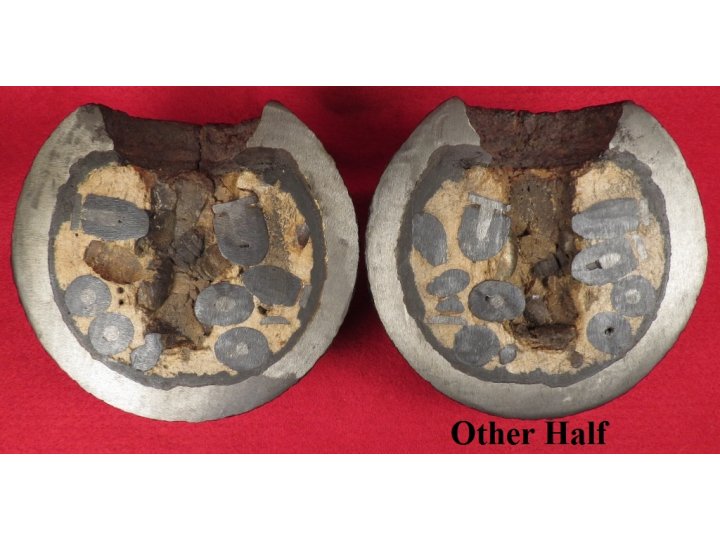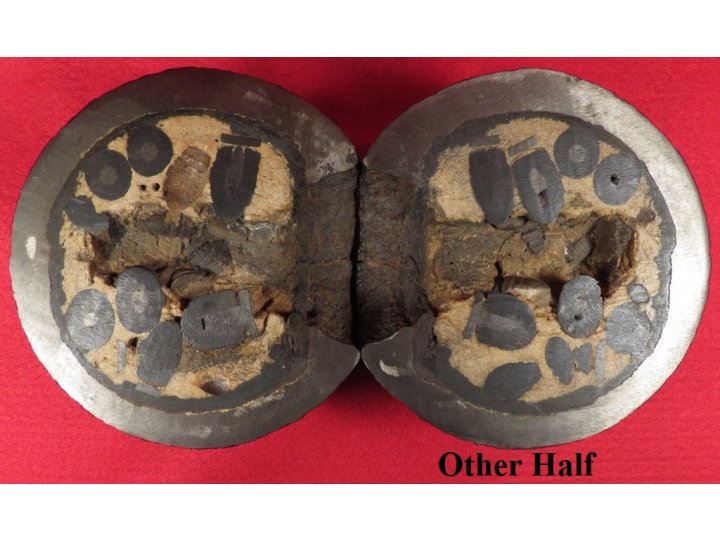- Home
- Virginia Relics
- 12 Pounder Cannonball Case-Shot Half for use w/ Rare Wright Time Fuze
12 Pounder Cannonball Case-Shot Half for use w/ Rare Wright Time Fuze
SOLD
Item: 12 Pounder Cannonball Case-Shot Half for use w/ Rare Wright Time Fuze
Construction: Cast iron with sulphur matrix.
Fuzing: Wright time fuze (not present).
Approximate size: Weight: 4.4 pounds. Diameter: 4.5 inches.
Condition: Very good, excavated. The exterior surface has moderate pitting and was run through electrolysis prior to being sawed in half. The cross-section view shows silhouettes of Williams cleaner bullets embedded in the matrix with a few protruding from the powder chamber, creating a very nice three dimensional effect. This case-shot has no repairs, has been deactivated and is ready for display.
Recovered: Petersburg, VA
Comments: This excavated half section of a 12 pounder artillery projectile is an excellent example that clearly shows the contents of a case-shot. Due to its use of the Wright time fuze which is no longer present, it is one of the scarcest versions of Civil War cannonballs that you can find. According to Pete George, co-author of "Field Artillery Projectiles of the American Civil War", these late-war case-shots have a current rating of 8+ on the 1-10 rarity scale. This particular case-shot was packed with bullets and sulphur which formed a deadly matrix. What is most impressive is the three dimensional way it displays. Not only are silhouettes of several bullets clearly visible along the cut surface, but there are additional bullets jutting out of the interior along the wall of the powder chamber which runs from the fuze opening down through the center of the case-shot. Shells filled with lead bullets would have created more carnage than one filled with just powder. This shell was specifically designed with a significantly larger fuze hole so that it would accept the Wright time fuze. According to Charles H. Jones' book "Artillery Fuses of the Civil War", "Wright's fuze was introduced late in the war, only a few field recoveries have been noted". Jones also states that this fuze was an improvement over the widely used Bormann fuze. This new design not only included a longer burning time while traveling through the air, from 5 seconds to 12 seconds, but also a safety feature that allowed the main powder charge to be withdrawn at any time without disturbing the fuze. Jones states, "This safety feature was included following an accident at the Washington Arsenal which cost several lives and did considerable property damage. A workman was trying to remove a Bormann fuze from a loaded shell, and in Wright's own words: "by the violent use of a cold chisel and hammer." This shell is a rare find and will be an excellent display piece or educational tool, as well as an excellent addition to any excavated Civil War artillery or general relic collection.
Note: The matching half to this case-shot is also available and has not yet been listed. As long as both halves are available, they can be purchased together at a discounted price. Images of both halves are included in the additional images. Just let me know if interested.
- Product Code:
- PC6913
MISSED OUT ON THIS ITEM?
I may have other similar examples not yet listed.
To find out:
Call or Text: 804-873-5462
Email: virginiarelics@comcast.net
- NEW ITEMS
- GREAT GIFT IDEAS
- RELICS ON SALE
- ALL PLATES
- ARTILLERY
- BAYONETS
- BOOKS
- BUCKLES
- BULK BULLETS
- BULLETS
- BULLET GROUPS
- CAMPSITE ARTWORK
- CANTEENS
- CARTRIDGES
- CARTRIDGE BOX PLATES
- CAVALRY
- CIVILIAN RELICS
- CONFEDERATE BUTTONS
- CONFEDERATE RELICS
- CURRENCY
- EAGLE PLATES
- EDGED WEAPONS
- FEDERAL BUTTONS
- FEDERAL RELICS
- FIREARMS
- HORSE EQUIPMENT
- INFANTRY
- INSIGNIA
- JUST OLD STUFF
- MAKER MARKED PLATES
- MARKED RELICS
- MISC. BUTTONS
- MISC. EXCAVATED ITEMS
- MISC. NON-EXCAVATED ITEMS
- MUSICAL RELICS
-
NORTH SOUTH TRADER MAGAZINES
- Volume I
- Volume II
- Volume III
- Volume IV
- Volume V
- Volume VI
- Volume VII
- Volume VIII
- Volume IX
- Volume X
- Volume XI
- Volume XII
- Volume XIII
- Volume XIV
- Volume XV
- Volume XVI
- Volume XVII
- Volume XVIII
- Volume XIX
- Volume XX
- Volume XXI
- Volume XXII
- Volume XXIII
- Volume XXIV
- Volume XXV
- Volume XXVI
- Volume XXVII
- Volume XXVIII (28)
- Volume XXIX (29)
- Volume XXX (30)
- Volume XXXI (31)
- Volume XXXII (32)
- Volume XXXIII (33)
- Volume XXXIV (34)
- Volume XXXV (35)
- Volume XXXVI (36)
- PACKAGED BULLETS
- PAPER ITEMS
- POST-CIVIL WAR & BEYOND ITEMS
- PRE-CIVIL WAR BUTTONS
- RELIC DISPLAYS
- SWORDS
- UNIFORMS
- VETERAN ITEMS
- WATER RECOVERIES



